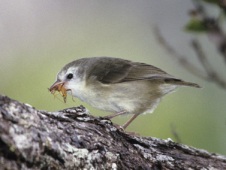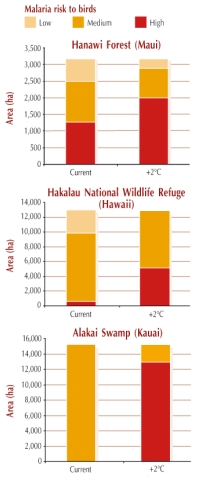
Endemic birds in the Hawaiian Islands have already been severely impacted by avian pox and malaria, transmitted by introduced mosquitoes. The area of forest with medium and low malaria risks for native bird species in forest reserves on three Hawaiian islands is predicted to decrease substantially following a temperature rise of 2ºC. Thus reforestation of pasture land at higher elevations will be crucial to improving the chances of survival for these species.

Endemic birds in the Hawaiian Islands have been severely impacted by avian pox and malaria, transmitted by introduced mosquitoes. These are restricted to the lowlands, so cooler high-elevation forests remain the last refuge for 18 threatened bird species, mainly honeycreepers (Drepanididae). In the Pacific islands, as elsewhere, climate change is predicted to lead to the lifting of the cloud-base, and consequent upward shifts of montane cloudforests (Still et al. 1999). Thus, in Hawaii, as temperatures rise, the altitudinal zone of malaria risk will also shift upwards. In some areas, the coolest (and hence safest) cloudforest zone is constrained in its upward shift, because the higher elevations have been cleared for pasture.
The effects of climate change on the extent of forests with high to low malaria risks have been modelled for three specific areas (representative of the most intact forest and highest abundance of native species) on the islands of Hawaii, Maui and Kauai (see figure; Benning et al. 2002). The results show increases in the areas of high malaria risk, and reductions or disappearances of areas with low risk. For example, a temperature increase of 2ºC will almost eliminate low malaria-risk forest in the Hakalau Wildlife Refuge on Hawaii (an important area for five threatened bird species). Forestation of pasture land above the refuge is crucial to improving the chances of survival of the endemic species.
This case study is taken from ‘The Messengers: What birds tell us about threats from climate change and solutions for nature and people’. To download the report in full click here.
References
Compiled: 2004 Last updated: 2015 Copyright: 2010
Recommended Citation:
BirdLife International (2015)
In Hawaii, climate change will increase the impact of disease.
Downloaded from https://datazone.birdlife.org/sowb/casestudy/in-hawaii-climate-change-will-increase-the-impact-of-disease on 22/12/2024